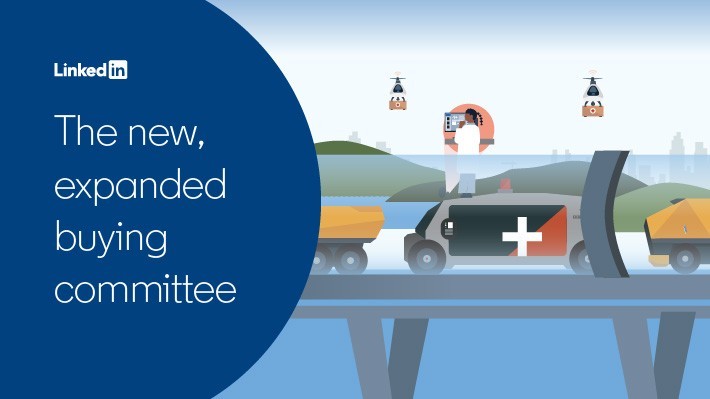Today, we’re all tech buyers: engaging the new, expanded buying committee
There was a time when IT was in the driving seat for nearly all technology buying decisions. Whether an organisation needed to purchase new laptops, a security system, a new CRM, or accounting software, it was invariably IT that would manage the buying process, assess the options, and have the final say.
But as technology has advanced to meet a vast range of business needs, the buying committee has also evolved. Now, individual departments and end-users are taking the wheel, supported by a wider group of influencers and advisors than ever before. Meanwhile, IT has moved into a supporting role, with the rise of cloud solutions meaning there is less need for their technical knowledge and input, than in years gone by.
In fact, the latest LinkedIn Technology Buyers Report, a survey of 2,000+ tech buyers across Europe, the Middle East and Africa, found that IT is the most influential stakeholder in only around a third (39%) of technology buying decisions, down from 75% in 2014. The upshot of this is that over half of tech decision-makers (56%) now sit outside the IT department.
So, with tech buying no longer the sole responsibility of the IT team, who exactly are these new tech decision-makers? And what does this shift mean for tech marketers?
Inspiring a buying team
So, who are the biggest buyers of tech?
You may or may not be surprised to hear that the most prominent decision-makers are in fact marketing professionals who, according to the LinkedIn report, now make up 16% of tech buyers. Marketers have wholeheartedly embraced digital tools to better target, track and engage audiences. But they’re not alone, with business development (14%), sales (13%) and finance (13%) also now taking a leading role. Meanwhile only one in ten of today’s buyers actually comes from IT.
Not only are more departments now making their own buying decisions, but each buying process has more stakeholders overall, with Gartner finding that, incredibly, the average tech purchase involves between 14 and 23 people. This is something that Sébastien Imbert, CMO at Microsoft France, has experienced first-hand:
“An opportunity will have twice as many stakeholders involved today compared to a few years ago,” he says. “The Chief Environment Officer is often one of the roles involved, and we’re having conversations with Chief Technology Officers, Chief Financial Officers and Chief Marketing Officers as well.”
So, tech buying has become a team pursuit, and for marketers, this means that top of the funnel brand building and thought leadership activities need to work harder, by telling a narrative that engages a much wider selection of audiences. This is what ServiceNow realized when it developed its recent brand campaign, “The Better Way to Workflow”, which it says sparks joy with audiences outside the IT department, using humour and emotion. It taps into the idea that, while IT is responsible for digital transformation “it is an emotion” felt across the business, by all departments.
Targeted content for new decision-makers
Crucially, the shift in buying influence means that many of today’s tech decision-makers are also end-users, which means they have a different set of priorities when assessing and reviewing their options. Rather than focusing on technical or price considerations, the LinkedIn Report found that tech decision-makers are looking for functionality, ease of use and business impact. As buyers move further down the funnel, tailored messaging and content must therefore highlight these specific needs, using data collected in the early stages to reach the right individuals with the right materials that cater to their interests.
“We try to become more buyer-oriented further down the funnel,” says Alysha Alysha Spencer, Head of Enterprise Acquisition and Upsell Marketing, O2. “As consumers, people increasingly expect bespoke, personalised experiences, and we want to be able to provide those too for our customers. We’re using data to understand the challenges for different functions so that we can really pull out the benefits for HR, IT or Operations and articulate them in our creative and messaging.”
IT's new role as ‘facilitator-in-chief’
Tech specialists haven’t been sidelined completely however, with over half of all decision-makers (57%) saying that IT is the department they are most likely to collaborate with during the buying process, followed by finance (39%) and procurement (29%). So, any of these stakeholders could still use their clout to put a halt to a deal if they don’t like what they see.
Furthermore, these ‘facilitators’ yet again have different priorities, with LinkedIn’s research showing that they are primarily focused on price, along with concerns around integration and adoption. Marketers must therefore ensure that targeted content addresses these issues and that salespeople have what they need to have meaningful conversations with all stakeholders involved across the buying team.
“We have automatic recommendations now within our CRM, which help sales to prioritise which roles they should engage with and which content they should use to engage them,” says Imbert. “With LinkedIn Sales Navigator you get a broader view of the customer and interact in a much more connected way. That’s really part of my job today – to ensure that we’re getting rich insights to the sales team that can be used on a day-to-day basis and interact with more of the roles involved in tech buying.”
It is an exciting time to be a tech marketer, with digital tools playing such an integral role in so many areas of business. A bigger and more diverse buying committee presents challenges, but also fantastic opportunities for vendors to be creative in broadening their appeal, through brand building and thought leadership, while maximizing data to develop targeted, personalised campaigns. For ambitious tech marketers, it’s a chance to show what they can really do.
The LinkedIn B2B Technology Buying Survey – Age of Agility EMEA Report 20/ 21 lays out the five key trends in a new and dynamic landscape for technology marketers. Discover what your buyers need from you today.
Topics: Targeting and audience building Tech marketing LinkedIn Ads
Related articles



